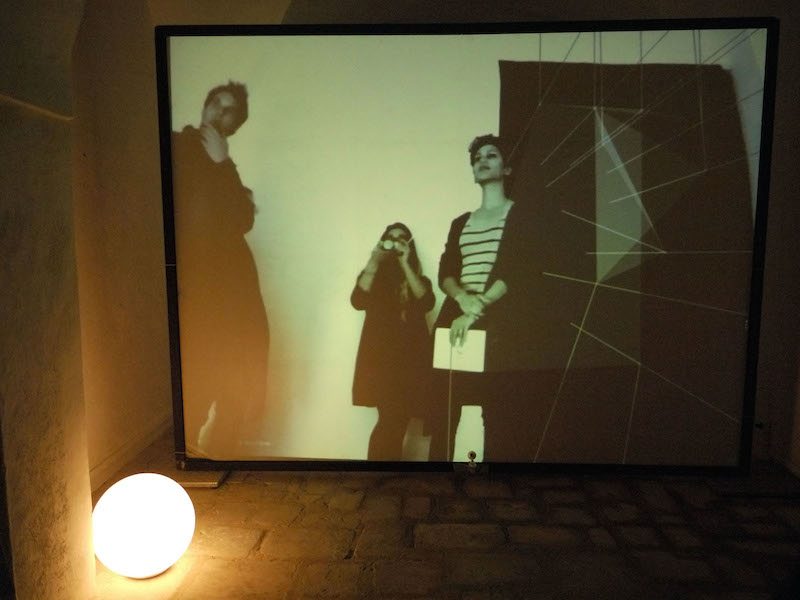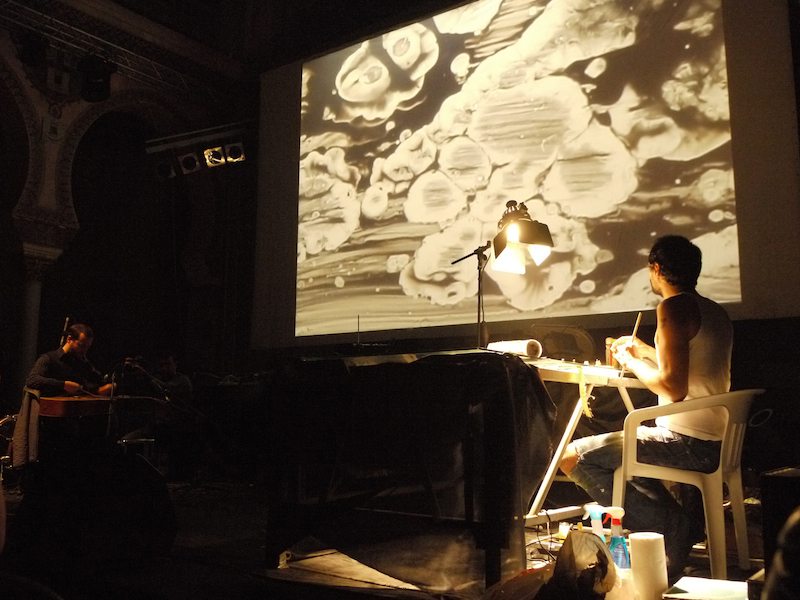Mixing voices
Tunis festival
Every year since 2007, Tunis has hosted an electronic music and arts festival known as the E-Fest Project. Just over a year after the first free election in Tunisia, and amid growing tensions with Salafist groups, the festival is an opportunity to encourage the development of a new cultural art scene.
Under the ceiling of the Acropolium, a former cathedral in the suburb of Tunis, on top of the Byrsa hill, a crowd of young people is watching a performance by Wormholes, a Lebanese duo. One is playing the guitar while the other is painting on a glass table.
Drops of ink fall on the glass while Mazen Kerbaj blows on it with a straw, drawing dark shapes which simultaneously get broadcast on the screen facing the public.
The abstract ink tracks appear and disappear on the screen. They are white and black, or red and black; drawings about Syria aimed at questioning the spectator. Kerbaj plays with the ink, throwing spinning tops on the glass to create random shapes. Meanwhile, music by Sharif Sehnaoui becomes trance-like, with copper rods in his guitar producing a unique melody. The fleeting sketches and recurring notes of the pair echo in the cathedral.
This year, artists from Lebanon, Tunisia, Morocco, France, Germany and Togo, among others, took part in the festival.
“These artists are really struggling to get recognition in their own countries. Then, they’re struggling even harder to travel abroad because to the north, there’s a barrier. That barrier is called visa,” says artistic director Afif Riahi.
The Tunisian, who has been directing the festival since it started, brings together artists from African and Arabic countries in order to showcase creativity in the region.
“Young people in these places can identify themselves through someone who represents them. Someone who looks like them, but who has made that step, to explore their creativity. Bringing these artists here is a way to tell others ‘you too can do it.’ We’re used to looking at everything that is created in the north and gets spread through the south, especially new technologies.”
27 year-old Amine Chouchene is a Tunisian DJ known as DJ Shenz. He has never played abroad, and the festival provides an opportunity to share the scene with artists from outside Tunisia.
“I’m really excited, and nervous, I’m waiting for ideas and feedback from people tomorrow. So far, I’ve played only in Tunisia but I’m hoping to do concerts abroad too.”
On top of being a DJ, Amine has to work as a service engineer to make ends meet. But he is not discouraged.
“I’m full of energy — like an African, like a Tunisian!” he says, laughing.
But the E-Fest project is not only about concerts. A sound exhibition is also held at the Abdellia palace, just north of Tunis.
“Since the beginning, the E-Fest’s aim has been to promote different forms of culture, visual arts and knowledge through exhibitions and workshops,” says Afif Riahi.
Having worked with Tunisian fellow artist Rihab Hazgui, French artist Jonathan Attar shows one of their common works at Abdellia. Attar has been living in Tunisia for a year and is impressed by the artistic scene and its vibrancy.
“I’ve met extraordinary people in Tunisia — especially through the festival — who express themselves, exhibit, and create things. It’s incredible. Since the revolution, there is a sort of effervescence people want to express.”
Last June at the Abdellia palace, a group of Salafists destroyed pieces of art which they considered blasphemous.
Art director Afif Riahi is trying to find a new way to bring creativity and culture to Tunisia and encourage artists from African and Arab countries.
“I don’t find in-your-face actions to be constructive. Usually, they’re even counterproductive. What’s productive is to manage to get your message through in a clear way. We need a cultural strategy in this country, but no one is working on it, not even the current government.”
All pictures are copyright Mathilde Arnaud, a graphic designer based in Tunis.










